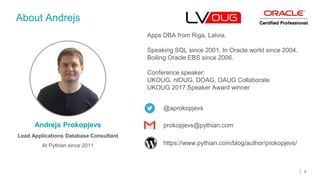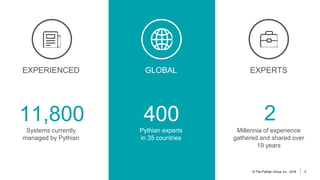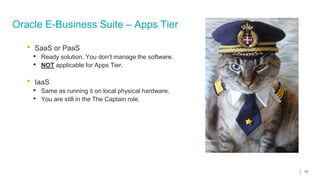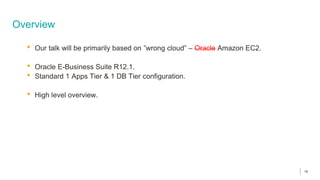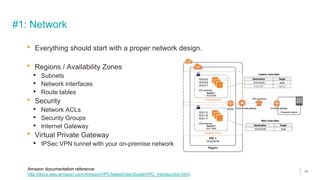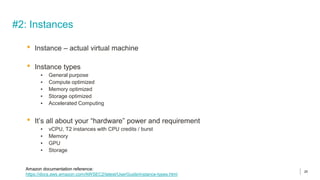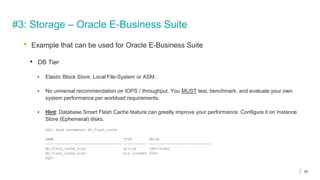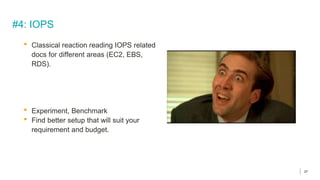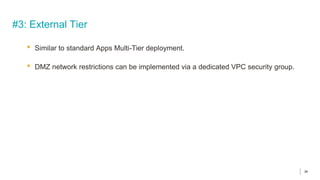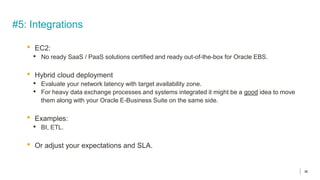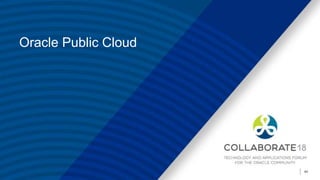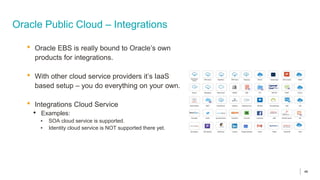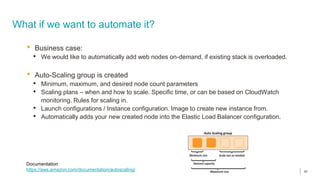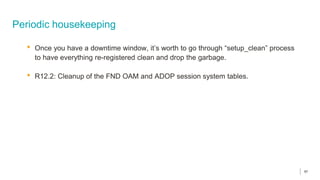Running Oracle EBS in the cloud (OAUG Collaborate 18 edition)
- 1. Session ID: Prepared by: Remember to complete your evaluation for this session within the app! 10078 Running Oracle EBS in the cloud April 24th, 2018 Andrejs Prokopjevs, John Piwowar Applications Database Consultants Pythian @aprokopjevs, @jpiwowar 1
- 2. About Andrejs 2 Apps DBA from Riga, Latvia. Speaking SQL since 2001. In Oracle world since 2004. Boiling Oracle EBS since 2006. Conference speaker: UKOUG, nlOUG, DOAG, OAUG Collaborate UKOUG 2017 Speaker Award winner Andrejs Prokopjevs Lead Applications Database Consultant At Pythian since 2011 @aprokopjevs prokopjevs@pythian.com https://www.pythian.com/blog/author/prokopjevs/
- 3. © 2017 Pythian. Confidential 3 About John - Apps DBA since 2005 - With Pythian (Apps DBA, Technical Project Manager) since 2011
- 4. Systems currently managed by Pythian EXPERIENCED Pythian experts in 35 countries GLOBAL Millennia of experience gathered and shared over 19 years EXPERTS 11,800 2400 © The Pythian Group Inc., 2018 4
- 5. Agenda • Certification basics. • How to architect. Recommendations. AWS. • Advanced configurations. • R12.2. • Microsoft Azure and Oracle Cloud review. • Cloud deployment automation and the most common scenario - auto-scaling. 5 What is Oracle EBS?
- 8. What is cloud? • It’s not just a hosting. • Infrastructure-as-a-service (IaaS) • Software-as-a-service (SaaS) • Platform-as-a-service (PaaS) • Public cloud, Private cloud, Hybrid cloud 8
- 9. What is cloud? • Pros • Hardware support and maintenance. This is your cloud service provider responsibility. • Hardware pool. Workload is shared and distributed. • Transparency. You run only what you need to run. • "Pay per use" model. • No termination fees. • Cons • Security ▪ Design of your network, its access, and security of the data is the main key point for success. ▪ Encryption ▪ Single Point of Disaster (AWS console). IAM and Root account protection. • Possible network latency with cloud service provider. 9
- 10. Oracle E-Business Suite – Apps Tier • SaaS or PaaS • Ready solution. You don’t manage the software. • NOT applicable for Apps Tier. • IaaS • Same as running it on local physical hardware. • You are still in the The Captain role. 10
- 11. Oracle E-Business Suite – DB Tier • AWS EC2 • Amazon RDS for Oracle (DBaaS) - NOT supported. • Sorry, only IaaS deployment. • MS Azure • Only IaaS for Oracle, in general. • Oracle Cloud • Something special is there. ▪ Database Cloud Service ▪ Exadata Cloud Service 11
- 12. Licensing • Licensing primary source: • http://www.oracle.com/us/corporate/pricing/cloud-licensing-070579.pdf • AWS EC2, MS Azure - Authorized Cloud Environments. • Example for Standard Edition: ▪ Less than 4 vCPUs: counted as 1 socket = 1 processor licensed. ▪ More than 4 vCPUs: "closest vCPU multiple of 4" counted as number of sockets = number of processors licensed. ▪ Azure - replace 4 vCPUs with 2 Azure CPU cores within your calculations. • Example for Enterprise Edition: ▪ 2 vCPUs = 1 processor licensed. ▪ Azure - replace 2 vCPUs with 1 Azure CPU cores within your calculations. • Licensing models • Pay per use rates, included in cloud service provider pricing model (* not everything applies). • BYOL (Bring Your Own License). Named User Plus licensing is possible. 12
- 13. Licensing – Oracle E-Business Suite • DB tier requires Enterprise Edition. • Pay per use model is available only on Oracle Cloud. • For other IaaS based deployments – BYOL. • Apps tier is separately licensed – BYOL. • VMware – Sorry ! Nothing changed. You need to license the whole hardware pool. • Cost efficiency: do your own calculations ! 13
- 15. Overview • Our talk will be primarily based on ”wrong cloud” – Oracle Amazon EC2. • Oracle E-Business Suite R12.1. • Standard 1 Apps Tier & 1 DB Tier configuration. • High level overview. 15
- 16. #0: Important start note • You are the Solution Architect. • How you design it will be the way the system is going to run. 16
- 17. #1: Network • Everything should start with a proper network design. • Regions / Availability Zones • Subnets • Network interfaces • Route tables • Security • Network ACLs • Security Groups • Internet Gateway • Virtual Private Gateway • IPSec VPN tunnel with your on-premise network 17 Amazon documentation reference: http://docs.aws.amazon.com/AmazonVPC/latest/UserGuide/VPC_Introduction.html
- 18. #1: Network 18
- 19. #1: Network • IP address • Private IP addresses – dynamic. Can’t be reserved and may change during instance restart. • Public IP addresses – dynamic, but a static IP address can be assigned via Elastic IP feature. ▪ Note: Public IP traffic is routed through the public internet. • DNS • By default provided by Amazon. • Each region has it’s own sub-domain. Automatically updated via internal DHCP. ▪ But contains Private IP address in the name space: • ec2-10-10-10-1.eu-central-1.compute.amazonaws.com • Route 53 ▪ Configure your own DNS. ▪ Assign host and domain names to instances. 19
- 20. #2: Instances • Instance – actual virtual machine • Instance types ▪ General purpose ▪ Compute optimized ▪ Memory optimized ▪ Storage optimized ▪ Accelerated Computing • It’s all about your “hardware” power and requirement ▪ vCPU, T2 instances with CPU credits / burst ▪ Memory ▪ GPU ▪ Storage 20 Amazon documentation reference: https://docs.aws.amazon.com/AWSEC2/latest/UserGuide/instance-types.html
- 21. #2: Instances • Instance types #2 ▪ On-Demand (default). ▪ Spot Instances – short term workload. ▪ Reserved Instances or Dedicated Hosts – long term resource pre-allocation. • Mainly affects pricing • AMIs (Amazon Machine Images) ▪ Image of the instance ▪ Public and Private repositories • What AMI to use? ▪ EC2 standard: RHEL, SLES, Windows Server, “pay per use” licensing model. ▪ Public AMI repos: Oracle Linux, for example. Use for free, but don’t forget about ULN licensing terms. 21
- 22. #2: Instances – Oracle E-Business Suite • Example that can be used for Oracle E-Business Suite • Apps Tier: m3.xlarge, 4 vCPU, 15 GB Memory. • DB Tier: r3.4xlarge, 16 vCPU, 122 GB Memory. • 122 GB RAM for Oracle EBS database? ▪ Sometimes memory size is not the primary criteria for instance type selection. ▪ Each instance type has different IOPS and IO throughput limits. 22
- 23. #3: Storage • Storage types • Amazon EBS (Elastic Block Store) • Standard SAN-like disk volumes. Can be mounted to one EC2 instance at a time. • SSD: gp2, io1. HDD: st1, sc1. Different throughput and IOPS limits. • Amazon EC2 Instance Store (Ephemeral) • Local disks. • IMPORTANT: All data is lost once Instance is stopped or restarted. Ideal for temporary storage. • Amazon EFS (Elastic File System) • NAS analog from Amazon – NFS based. Still with a limited region availability. • Amazon S3 • Object based storage module. • By default used for storing AMIs and Amazon EBS disk snapshots. 23 Amazon documentation reference: http://docs.aws.amazon.com/AWSEC2/latest/UserGuide/Storage.html
- 24. #3: Storage – Oracle E-Business Suite • Example that can be used for Oracle E-Business Suite • Apps Tier file system ▪ Elastic Block Store – standard option for single Apps Tier approach. ▪ Elastic File System is preferable if scale-out plans are there. ▪ Make your own “NAS server” instance, mount Amazon EBS disks, and export them via NFS. ▪ gp2 standard type is absolutely enough. Based on IO credits / burst. ▪ Cheap HDD based disks should be considered only for low IO workload targets (conc. log / out data, or interfaces). 24
- 25. #3: Storage – Oracle E-Business Suite • Example that can be used for Oracle E-Business Suite • DB Tier ▪ Elastic Block Store. Local File-System or ASM. ▪ No universal recommendation on IOPS / throughput. You MUST test, benchmark, and evaluate your own system performance per workload requirements. ▪ Hint: Database Smart Flash Cache feature can greatly improve your performance. Configure it on Instance Store (Ephemeral) disks. SQL> show parameter db_flash_cache NAME TYPE VALUE ------------------------------------ ----------- ------------------------------ db_flash_cache_file string /dev/xvda1 db_flash_cache_size big integer 200G SQL> 25
- 26. #4: IOPS • Most difficult part to understand. • IOPS / Throughput depends not only on Instance and Storage type, but also on the size of the volume. • Provisioned IO (io1) volumes are not always the most efficient option for IO intensive workload. ▪ Larger “gp2” volumes can provide similar or better IO performance than smaller “io1”. And for less cost. ▪ Can experiment putting multiple gp2 into LVM drives. • Wrong type chosen can be a big problem. ▪ Example: cheap HDD “sc1”. • IOPS size: ▪ SSD (gp2, io1) - 16KiB. ▪ HDD (st1, sc1) - 1 MiB. • Oracle Database: multiblock reads ▪ DB IOPS <> EC2 IOPS !!! 26
- 27. #4: IOPS • Classical reaction reading IOPS related docs for different areas (EC2, EBS, RDS). • Experiment, Benchmark • Find better setup that will suit your requirement and budget. 27
- 28. #5: Backup / Recovery • EC2 provides EBS storage snapshot feature only ▪ Apps tier: Make snapshots for Apps Base file system. ▪ DB tier: • Setup RMAN on dedicated volumes. Make periodic snapshots. • Elastic File System (NAS). • S3 sync for backup sets, but requires complex scripting effort. ▪ Can be automated via CLI. 28 Amazon documentation reference: http://docs.aws.amazon.com/AWSEC2/latest/UserGuide/ebs-creating-snapshot.html
- 29. #6: Monitoring • CloudWatch • https://aws.amazon.com/cloudwatch/ • Free: • Very limited. • Paid: • Complete monitoring solution for the instances. • Alarms. SWS / SNS integration. • Not versed for Oracle. • You can use your own custom monitoring. Setup EM agents. 29
- 30. #7: Amazon RDS • You can still use RDS for Oracle service for other integrated components. • Oracle Fusion Middleware 12c • Not supported with Oracle Fusion Middleware 11g, but with some “tweaks” you can still get your Metadata Repository loaded into the RDS instance. ▪ Main challenge: no SYSDBA access. Replaced with ORACLE_MASTER and RDS PL/SQL API. ▪ Doable, but not certified and not supported. • Example: • Identity and Access Management for Single Sign-On, or BI. 30
- 32. #1: Oracle RAC • NOT supported. • No shared storage. • No multicast support for interconnect. • But… non-official solutions. • Deploying Scalable Oracle RAC on Amazon EC2 ▪ https://aws.amazon.com/articles/7455908317389540 ▪ Became an official guide by Amazon. • Do your own interconnect via OpenVPN. • Flashgrid VSAN solution. • Try to adopt Amazon EFS (NFS). • Complex and not recommended. 32
- 33. #2: Apps Multi-Tier / PCP • No limits. • Shared file-system can be implemented via EFS or your own NFS solution. • Elastic Load Balancing (LBaaS) • Has all requirements to front-end Oracle E-Business Suite. ▪ Sticky session ▪ SSL 33 Amazon documentation reference: https://docs.aws.amazon.com/elasticloadbalancing/latest/userguide/what-is-load-balancing.html?icmpid=docs_elbv2_console
- 34. #3: External Tier • Similar to standard Apps Multi-Tier deployment. • DMZ network restrictions can be implemented via a dedicated VPC security group. 34
- 35. #4: SSL • Native SSL – same as on-premise. • SSL termination via ELB (LBaaS). • AWS Certificate Manager is available to maintain and provision the certificates. 35
- 36. #5: Integrations • EC2: • No ready SaaS / PaaS solutions certified and ready out-of-the-box for Oracle EBS. • Hybrid cloud deployment • Evaluate your network latency with target availability zone. • For heavy data exchange processes and systems integrated it might be a good idea to move them along with your Oracle E-Business Suite on the same side. • Examples: • BI, ETL. • Or adjust your expectations and SLA. 36
- 37. #6: Disaster Recovery • IaaS – similar “on-premise” approach. • No automation. • Availability zones. Regions. • For initial clone, EC2 EBS volume snapshots are transferable. • RDS for Oracle (DBaaS) – built-in and automated feature. • But between Availability Zones, not Regions. 37
- 38. #7: Encryption • Applications level: implement TDE. • Storage level: implement encryption at rest for EC2 EBS volumes. 38
- 39. R12.2 39
- 40. What is different with R12.2? • Everything that is related to R12.1. • ADOP • Private IP addresses ▪ Number of FND tables must contain valid IP addresses of all nodes. ▪ EC2 Instance restart might change the private IP – it must be updated. • Validation of the /etc/hosts ▪ Same private IP addresses – hosts file has to enlist them, and with required format. • You can setup a custom OS service ▪ Run during instance startup to update hosts file and FND table with $(hostname -I) value. ▪ Any other node dependencies via AWS CLI. • IOPS / IO throughput planning is important ▪ ADOP fs_clone and file system synchronization management through online cycles. ▪ DB workload handling edition objects. ▪ Example: “fs_clone force=yes” run duration on 220 GB standard gp2 volume: 42 minutes. 40
- 42. Microsoft Azure • IaaS only. • In respect to Oracle E-Business Suite it has all main analogs available. • Virtual Network, Load Balancing, Storage, Site Recovery. • Linux Virtual Machine support. • Important note: compute limits. • Main disadvantage comparing EC2 and Azure was the compute option availability. EC2 provided more powerful capacity options. Almost 10 times. • Things are getting changed. ▪ 20 vCPU max quota (30 West Europe region). But can be extended via support request. ▪ 100+ GB RAM. ▪ Enough storage options. 42
- 44. Oracle Public Cloud • Completely based on Oracle’s own stack. • IaaS • With PaaS support for DB Tier: • Database Cloud Service • Exadata Cloud Service • RAC support !!! • “Lift and Shift” – “one-button” your on-premise instance migration to cloud. • Easy multi-node provisioning for Oracle EBS. • Quick deployment for rapid development needs. 44
- 45. Oracle Public Cloud – Management • EBS Cloud Admin Tool central management. • Provisioning. • Vertical scaling. • Cloning. • OpenWorld 2017 roadmap announcement: • Managed Oracle EBS environment via GUI console or CLI. • Full scaled and managed Backup / Restore for Oracle EBS instance. • Automated provisioning and cloning, with post provisioning custom framework support. • Managed horizontal scaling. • Automated DMZ and External application configuration. • Automated DB tier PSU patching. • Fully automated DR creation and failover. • GUI management portal is coming !!! 45
- 46. Oracle Public Cloud – Integrations • Oracle EBS is really bound to Oracle’s own products for integrations. • With other cloud service providers it’s IaaS based setup – you do everything on your own. • Integrations Cloud Service • Examples: ▪ SOA cloud service is supported. ▪ Identity cloud service is NOT supported there yet. 46
- 47. Oracle Public Cloud – EBS or SaaS Applications • There is an ongoing shift to SaaS based Applications. • Limited modules are implemented. Still in active development. • Oracle’s vision for Hybrid co-existence (options in R12.2). • Oracle E-Business Suite is still on the radar. • Roadmap, at least, till 2030. R12.3 (or maybe R18.1 ) is on the way (~2020). • Recommendation: Do not rush! • Implement, Test, Evaluate, Compare costs, Migrate. 47 Getting Started with Oracle E-Business Suite on Oracle Cloud (Doc ID 2066260.1) https://www.facebook.com/groups/EBS.SysAdmin/ https://twitter.com/Oracle_EBS
- 49. What is Vertical scaling? • Increase of the compute resources of a particular instance • Change instance type with more RAM, more compute power. • Might dramatically increase your cost. • Still has limits. • In respect to Oracle EBS • JVM memory heap size increase. • JVM process / server count increase. • Downtime 49
- 50. What is Horizontal scaling? • Increase of the compute resources by adding more compute instances • Add more nodes • Flexibility • In respect to Oracle EBS • Add more apps tiers. • No Downtime 50
- 51. What if we want to automate it? • Business case: • We would like to automatically add web nodes on-demand, if existing stack is overloaded. • Auto-Scaling group is created • Minimum, maximum, and desired node count parameters • Scaling plans – when and how to scale. Specific time, or can be based on CloudWatch monitoring. Rules for scaling in. • Launch configurations / Instance configuration. Image to create new instance from. • Automatically adds your new created node into the Elastic Load Balancer configuration. 51 Documentation https://aws.amazon.com/documentation/autoscaling/
- 52. What if we want to automate it? • New node startup from AMI • We can put a custom first-boot shell script which will handle certain actions (cloud-init). • Pricing for Auto-Scaling • It is free. • You pay only standard rates running your additional EC2 compute resources. • Limits 52
- 53. Oracle E-Business Suite - Challenge • Oracle E-Business Suite is very tight on it’s internal configuration repository • FND tables, like FND_NODES • Nightmare with R12.2 and ADOP. • Scaling with a new node. • Find the best combination of pairs file to minimize post manual correction of the context file and instance configuration for “perl adclonectx.pl addnode”. • Manually generate the required context file and feed it into adclonectx.pl. • Node deletion • R12.1: Downtime, setup_clean, re-run of all autoconfigs on each node in 2 rounds. • R12.2: supports Abandoned node state, supports node deletion*** 53
- 54. Adding a new Web Node • OS setup • Software, kernel, limit configuration can come from created private AMI image. • Hostname: We need to set a unique hostname on the server, DNS, update /etc/hosts. • Mount the Apps Base storage layer. • Apps setup • Generate new context file / perl adclonectx.pl addnode. • Run AutoConfig on all existing nodes. Or, at least, “generatetns” step. • Reload Apps TNS listeners on all existing nodes. • Optional: any custom post configuration. • Service restart on new created node. • Elastic Load Balancer • Will enable the node once the TCP socket ping succeeds. 54
- 55. Removing a Web Node • Instance termination • Elastic Load Balancer – automatic drop of the removed instance • Apps setup - Master node to trigger the node deletion process. • R12.1 ▪ No process of node deletion without a complete downtime and setup_clean process. ▪ Concurrent Service Managers configured for new node can be just disabled from back-end. ▪ OAM dashboard – sorry, you can’t avoid the red status there. ▪ File system cleanup. • R12.2 ▪ Abandon the node. ▪ “perl $AD_TOP/patch/115/bin/adProvisionEBS.pl ebs-delete-node” ▪ “txkSetAppsConf.pl -configoption=removeMS” ▪ File system cleanup. 55
- 56. Re-use of a removed Web Node • Node remove is very costly. Re-use of the existing configuration can be easy. • R12.1 • Easy. But we should not delete the INST_TOP then. • Re-enable the Concurrent Service Managers. • Just launch the instance, configure the OS part, and restart the services. • R12.2 • Abandoned node – only a complete delete / add process. • Required even if we do not delete the node and do not delete the file system content. • We can’t allow to delete an instance without Abandoned node state – affects ADOP. 56
- 57. Periodic housekeeping • Once you have a downtime window, it’s worth to go through “setup_clean” process to have everything re-registered clean and drop the garbage. • R12.2: Cleanup of the FND OAM and ADOP session system tables. 57
- 58. R12.2 ADOP considerations • Scaling automation and ADOP online patch cycle – how safe it is? • Scale out: process creates a new node for RUN file system. PATCH – fs_clone requirement. Conflict if a cycle is already opened. • Scale in: abandoned node state is safe to complete the cycle. • Cutover: likely a failure is expected. • CloudWatch doesn’t know anything about what’s going on in Oracle EBS. • During ADOP open cycle or maintenance window Auto Scale group, probably, should be completely disabled. 58
- 59. Summary • Oracle EBS implementation on cloud is more less straightforward. • Mostly IaaS. Oracle Public Cloud offers PaaS for Oracle Database and other integrations, like SOA. • IO performance is the main bottleneck risk. Good design, evaluation of estimates and testing are required to confirm the requirements. • Security is an extra overhead and highly important. • Cost efficiency is a subject of detailed evaluation and calculation. • Auto-scaling – interesting, possible, but still is a manually controlled process. 59
- 60. Session ID: Remember to complete your evaluation for this session within the app! 10078 Thank you Q & A 60

